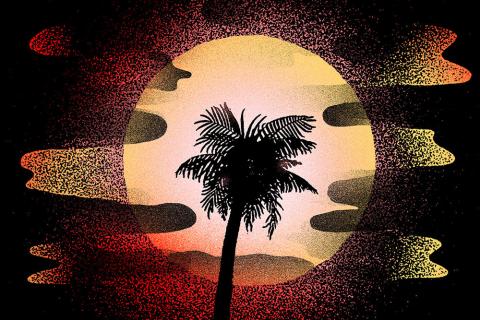My poem “Sunfall with Bat House” was inspired by the University of Florida’s bat houses, some of the largest occupied urban bat houses in the world. A few years ago, I started taking my environmental writing classes to see the bats as part of a series of field trips. The bat houses have an interesting history and serve as an excellent example of making space for coexistence. The colony originally occupied a historic building on campus, but when a kitchen grease fire erupted in 1987 and burned it to the ground, they fled to the football stadium. Fans found their musky guano unpleasant, and the bat houses were built to provide a more isolated roost. In their new home, the bats are no longer a nuisance but instead a welcome part of the campus ecology, turning insects into guano used for fertilizer.
Anyone who has spent time out of doors in North-Central Florida on a warm evening will appreciate an animal that consumes upwards of 1,000 insects an hour (this colony is responsible for more than 2,500 pounds of bugs per night). Yet, the bats are more than productive members of the campus. Watching the bats emerge from their roost is truly an awesome spectacle. As the afternoon leans into dusk, a few bats circle the field, as if they were crowd warmers, building our anticipation. Just as the world starts to saturate with the blue of night, the bats pour out of every crevice of the stilted houses. They form a pulsing river as they pass over the field before separating into two steady streams. One moves above the crowd to feast on insects over nearby Lake Alice, and the other splits off toward the distant horizon of short-leaf pines.
In “What Is It Like to Be a Bat?,” Thomas Nagel uses bats to refute reductionist accounts of consciousness. Bats are well suited for his famous thought experiment because, he claims, “[e]ven without the benefit of philosophical reflection, anyone who has spent some time in an enclosed space with an excited bat knows what it is to encounter a fundamentally alien form of life.” My students often share Nagel’s sense of bats as alien creatures, objects even of fear and trepidation. Some arrive at the bat houses dressed in ponchos and large hats for protection. In many ways, it is the strangeness of bats that makes seeing them sublime. As we stand there, watching the work of a consciousness so different from our own, we are sometimes transported, if only for a moment, from our own human worlds of deadlines, grades, and daily troubles to consider that which is distinctly different from us.
For the bats, each night brings a mundane act of survival, but for the crowd gathered to see them, it is a chance to witness a more-than-human world. A visit to the bat house is a chance to open yourself to that world, to revel for a few minutes in what is an increasingly rare magic. Like the guano, the elation one feels when watching bats is a by-product, reminding us of our links to a world that precedes our sense of wonder and beauty, our very impulse toward art. The poem is both an attempt to record the experience of watching the bats leave their roosts at night and an acknowledgement of the impossibility of using language to capture this tiny, nightly miracle. I am grateful to North American Review for giving this poem a place to roost.
Note: the Florida Museum of Natural History’s website features streaming video of the bat houses and information about the bats and the project’s history. You can read about the history of the bat houses here.
Illustration by: Daniel Zender.




